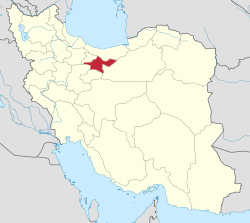Parand
 From Wikipedia - Reading time: 9 min
From Wikipedia - Reading time: 9 min
This article needs additional citations for verification. (February 2017) |
Parand
Persian: پرند | |
|---|---|
City | |
 Apartment building in the city of Parand | |
| Coordinates: 35°28′45″N 50°56′32″E / 35.47917°N 50.94222°E[1][2] | |
| Country | Iran |
| Province | Tehran |
| County | Robat Karim |
| District | Central |
| Established as a city | 2013[3] |
| Population (2016)[4] | |
• Total | 97,464 |
| Time zone | UTC+3:30 (IRST) |
Parand (Persian: پرند) is a planned city[5] in the Central District of Robat Karim County, Tehran province, Iran. Its toponym means "natural silk".
History
[edit]The city is intended to provide residences for the staff of Imam Khomeini International Airport, and to create a balance in the settlement pattern of Tehran, establish an appropriate environment to draw in the extra population of Tehran and offer an alternative to unsystematic settlements. Parand is expected to accommodate 483,000 people on 3,420 hectares of land.[3]
The plan was a well-planned city which responds to the community's needs. It aims to host low-income families (laborers’ and employees’ housing cooperatives) by providing low-priced residential units with bank loans thereby attracting various classes of people. In 2019, the city has not yet attained those goals.[citation needed]
On 8 January 2020 Ukraine International Airlines Flight 752 crashed approximately 15 kilometres north-east of the city shortly after takeoff from nearby Tehran Imam Khomeini International Airport, killing all 176 people on board.[6] A video of a missile hitting the plane was recorded from the city.[7][8][9]
In 2023, it was estimated that Parand will have 11 phases in the future, six of which are operating.
Demographics
[edit]Population
[edit]At the time of the 2016 National Census, the city's population was 97,464 in 31,693 households.[4]
Geography
[edit]The city of Parand is 10 km west from the city of Robat Karim (35 km southwest from Tehran) on the way to Saveh. It has about 13,000 students in Islamic Azad University of Parand. The city is also accessible from Tehran Imam Khomeini International Airport via the Tehran-Qom freeway.
The city is divided into a number of areas, namely an urban texture, greenery, town services, regional services, and an industrial district.
See also
[edit]![]() Media related to Parand at Wikimedia Commons
Media related to Parand at Wikimedia Commons
References
[edit]- ^ OpenStreetMap contributors (22 September 2024). "Phase Four, Parand, Robat Karim Central District, Robat Karim County, Tehran Province, Iran" (Map). OpenStreetMap (in Persian). Retrieved 22 September 2024.
- ^ "FWHR+MV9 Shahr-e Jadid-e Parand, Tehran Province, Iran" (Map). Google Maps. Retrieved 24 June 2025.
- ^ a b Gharavi, Mir-Mohammad (29 April 2013) [تاریخ تصویب (Approval date) 1392/02/09 (Iranian Jalali calendar)]. شورای عالی شهرسازی و معماری ایران در خصوص طرح جامع اراضی ۱۲۰۰ هکتاری الحاقی مصوب در شهر جدید پرند و تغییرات طرح جامع شهر جدید پرند [Supreme Council of Urban Planning and Architecture of Iran regarding the master plan of 1200 hectares of additional land approved in the new city of Parand and changes to the master plan of the new city of Parand]. لام تا کام [Lam ta Kam] (in Persian). هیات وزیران [Council of Ministers]. شورای عالی شهرسازی و معماری ایران [Supreme Council of Urban Planning and Architecture of Iran]. شماره ابلاغیه ۳۰۰/۶۹۴۸ [Notification number 300/6948]. Archived from the original on 22 June 2025. Retrieved 22 June 2025.
- ^ a b سرشماري عمومي نفوس و مسكن 1395 : استان تهران [General Population and Housing Census 2016: Tehran Province]. مرکز آمار ایران [Statistical Centre of Iran] (in Persian). Archived from the original (Excel) on 12 December 2021. Retrieved 24 June 2025.
- ^ معرفی شهرستان رباط کریم [Introducing the county of Robat Karim]. Robat Karim Municipality Portal (in Persian). 1 December 2022 [10 آذر 1401 (Iranian Jalali calendar)]. Archived from the original on 1 December 2022. Retrieved 22 June 2025.
- ^ Safi, Michael (8 January 2020). "Iran plane crash: Ukraine Boeing with more than 160 on board comes down near Tehran". The Guardian.
- ^ "Video Shows Ukrainian Plane Being Hit Over Iran". New York Times. Archived from the original on 9 January 2020. Retrieved 9 January 2020.
- ^ "Video appears to show Ukrainian airliner being hit". CNN. 9 January 2020. Archived from the original on 9 January 2020. Retrieved 9 January 2020.
- ^ "Cellphone video purports to show moment plane struck by Iranian missile" on YouTube
External links
[edit]
 KSF
KSF
